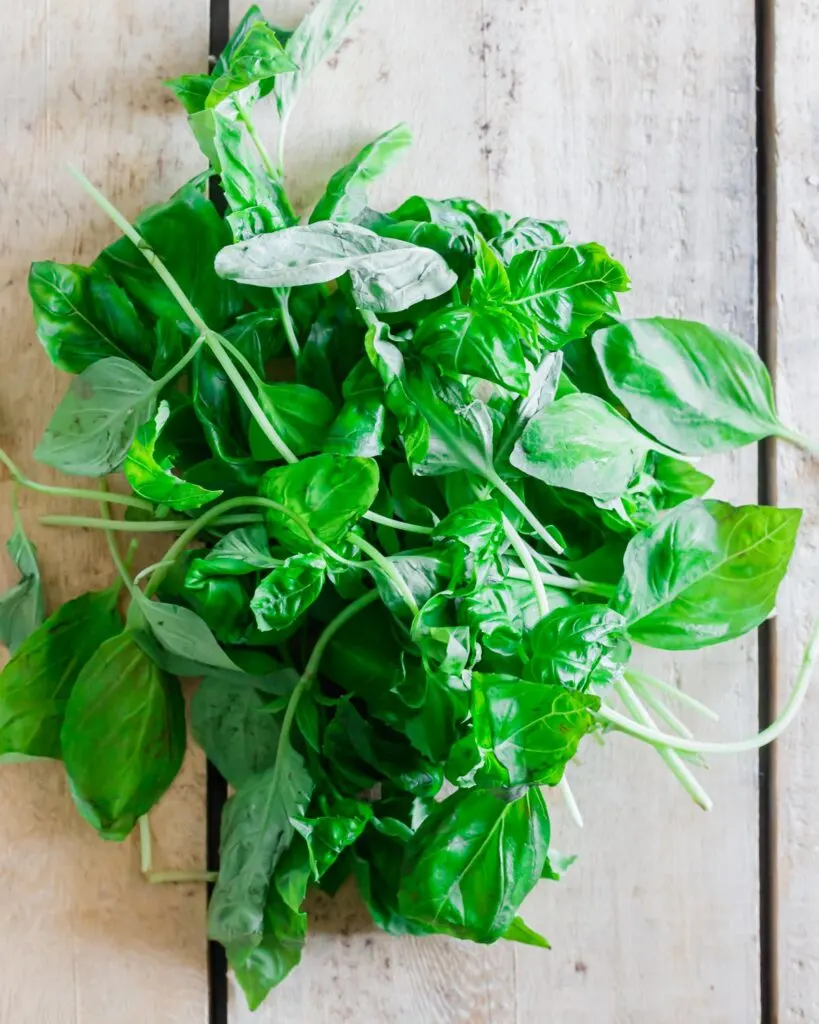In the quest to feed our dogs the best foods possible for a long happy and healthy life, you may want to know – can dogs eat basil?
If you’re considering adding this ubiquitous summer herb to your dog’s diet, read this first to find out if both fresh and dried basil can be a safe addition to a dog’s diet.

WHAT IS BASIL?
Before answering the question of whether or not it’s safe to feed your dog basil, let’s define what basil plants are.
Basil is a culinary herb from the Lamiaceae family. It’s a tender plant native to warmer, tropical regions with many varieties.
It has a very fragrant smell, almost on the sweet side but with hints of peppery flavor as well.
Basil is a common herb best known for its use in Italian cooking to make things like pesto or garnish fresh pasta dishes it’s often paired with garlic, parmesan cheese and pine nuts.
Lots of amateur gardeners will grow a plant in pots or a small container garden for cooking use so knowing if fresh herbs like basil are safe for your furry friend to eat (whether purposely or by accident) is important.
CAN YOU FEED BASIL TO DOGS?
Yes, dogs can eat basil. Like cilantro, basil is not a toxic herb to dogs and can safely be given to them in either fresh or dried form.
This is not the case with all plants. For example, elderflower (the plant from which elderberries grow) can be extremely toxic to dogs.
As always, the dose matters and moderation is important. The amount of basil small dogs can tolerate is much different than a larger breed.
Just because a human food is safe for a dog to eat, the question still remains about whether or not it’s needed in a dog’s diet.
This is where we’ll explore the potential health benefits of basil for dogs.
WHAT ARE THE HEALTH BENEFITS OF BASIL FOR DOGS?
Basil is not only a flavorful culinary addition to soups, salads and sauces for humans, it’s also nutritious with numerous health benefits!
BASIL NUTRITION
Essential vitamins found in basil include vitamin A, vitamin K and calcium, manganese, iron, magnesium, zinc and potassium.
Vitamin K is helpful allowing blood to clot properly in dogs while vitamin A can help promote healthy eye sight.
ANTIOXIDANTS
Many studies show the benefit of the high levels of antioxidants found in basil. These powerful compounds help fight free radicals in the body and can therefore aid in reducing inflammation.
Foods high in antioxidants have been shown to help fight many illnesses including cancer.
They’re a powerful intervention for preventing cell damage in both humans and canines and if your pup suffers from arthritis, basil can definitely be a worthwhile addition to their diet!
BLOOD SUGAR CONTROL
A few studies have been done to explore the beneficial effects basil can have on regulating blood sugar on animals (source).
If your dog suffers from elevated sugar levels or has been diagnosed with health issues like diabetes, basil may be a helpful tool.
DIGESTIVE AID
For dogs with digestive problems, small amounts of basil may help alleviate stomach upset.
The compound called eugenol found in the basil plant facilitates a healthy digestive system.
ADAPTOGENIC PROPERTIES
Adaptogens are natural substances considered to help the body adapt to stress. They deliver a normalizing and calming effect upon bodily processes.
Basil is actually considered an adaptogen powerful enough to help deal with signs of depression or anxiety.
If you have an anxious dog, basil may be an easy way to help your dog’s health!
Essential oils with basil in them are popping up frequently now for this purpose.
It’s best to use caution with oils, however, and contact your vet about how to use them (if at all) with your dog. They’re in a market that can be clouded with (lack of) regulation.

WHAT TYPES OF BASIL CAN DOGS EAT?
There are many different varieties of basil including, sweet basil, Thai basil, purple basil, Holy basil and Tulsi to name just a few.
Then, there’s also raw/fresh basil vs. dried basil to consider.
Wondering what types of basil are safe for dogs?
Thankfully, if you’re looking to incorporate basil as a new food for your dog, all these varieties of the plant are safe for their consumption.
And, both raw basil and cooked basil are ok so long as they’re not paired with other toxic herbs or foods.
CAN DOGS EAT FOODS CONTAINING BASIL?
There’s an important distinction to be made between feeding a dog basil and feeding a dog a food containing basil.
While basil itself is a non-toxic food for dogs, many of the prepared dishes it’s used in for human consumption are not safe for dogs to eat.
Since garlic, onions and leeks are toxic to dogs, it’s imperative to make sure the basil is not combined with any of these ingredients before giving to your dog.
Basil pesto is probably the most common recipe in human cooking and almost always contains garlic so beware.
You can, however, make your own homemade pesto that’s dog friendly without garlic and use that as a flavoring component in your dog’s normal food.
The one ingredient basil is often paired with that is safe for dog consumption, however, is olive oil. Cold pressed extra virgin olive oil has been shown time and time again to be a healthy fat choice loaded with beneficial polyphenols.
Of course, be mindful of how much added fats like oil are included as too much of any fat (like butter) can be harsh on their tummies.
HOW MUCH BASIL SHOULD A DOG EAT?
The answer to this question of course depends on your dog. As with most foods outside of a dog’s normal diet, it’s best to practice moderation.
A small amount of basil in their regular dog food or baked into dog treats on occasion can be a positive addition to a dog’s diet. These fresh breath dog biscuits are a fun recipe idea – just swap out the parsley for basil!
But this should be based on your specific pet’s size.
If you have questions about how much of the herb to incorporate into your dog’s diet, be sure to check in with your veterinarian.
And always be on the lookout for any adverse reactions the first time you introduce any new food to your dog.
It’s best to start with just a bit of basil (1/4-1/2 teaspoon) and work up to a maximum of 1-2 teaspoons.
DO DOGS LIKE BASIL?
By nature, dogs are carnivores.
Some, however, will eat anything in sight while others will be a bit more picky.
Don’t be surprised if your dog doesn’t take to the strong smell and flavor of basil, this is a completely normal reaction.
Some dogs may love it while others will express no interest whatsoever.
Remember, dog’s are meant to eat mainly meat. Basil should only ever be used like a condiment when including it in a dog’s diet.
HOW TO SERVE BASIL TO DOGS
If, as a pet parent, you decide to start incorporating this herb into your dog’s food first test your dog’s palate out by trying some finely chopped in their food.
If they’re ok with that, you may have a dog that’s open to consuming basil that way which is definitely the easiest! Both raw and dried basil can be added to your dog’s food.
This homemade dog food seasoning is a fun way to do that!
If fido isn’t too keen on eating basil that way, you may have to get more creative by baking it into treats or hiding it in homemade raw dog food.
It’s great for creating a dog-friendly ketchup too!

CAN BASIL BE HARMFUL TO DOGS?
While the herb is not outright toxic to dogs, it’s important to be on the lookout for any new negative effects that arise after testing basil out with your dog.
LOOSE STOOL
It’s unlikely as the amounts will be so small but if your dog happens to consume an entire basil plant in the yard or something similar, loose stool could become a problem.
The fiber in a basil plant is usually the culprit for this. Eating that much added fiber at one time can make a dog’s digestive system hyper-motile.
If this happens loose stool or potentially diarrhea can happen. This will usually pass on its own but keep a watchful eye on your pup for any more concerning signs such a blood.
ALLERGIC REACTION
As with any food, it’s possible to have an allergic reaction. If you have reason to suspect your dog may be allergic to basil, do not feed it to them.
Signs to look out for when experiencing allergic reactions include: vomiting, itchiness, diarrhea, fever, panting and lethargy.
If you see any of these after ingestion of basil, take your dog to the vet immediately.
CAN PUPPIES EAT BASIL?
It’s usually best to err on the side of caution with puppies.
While basil can be fed to a growing pup, make sure to clear this addition to their diet with your vet first before trying.
If you do try basil, do so in very small amounts with a puppy and watch for any negative side effects.
